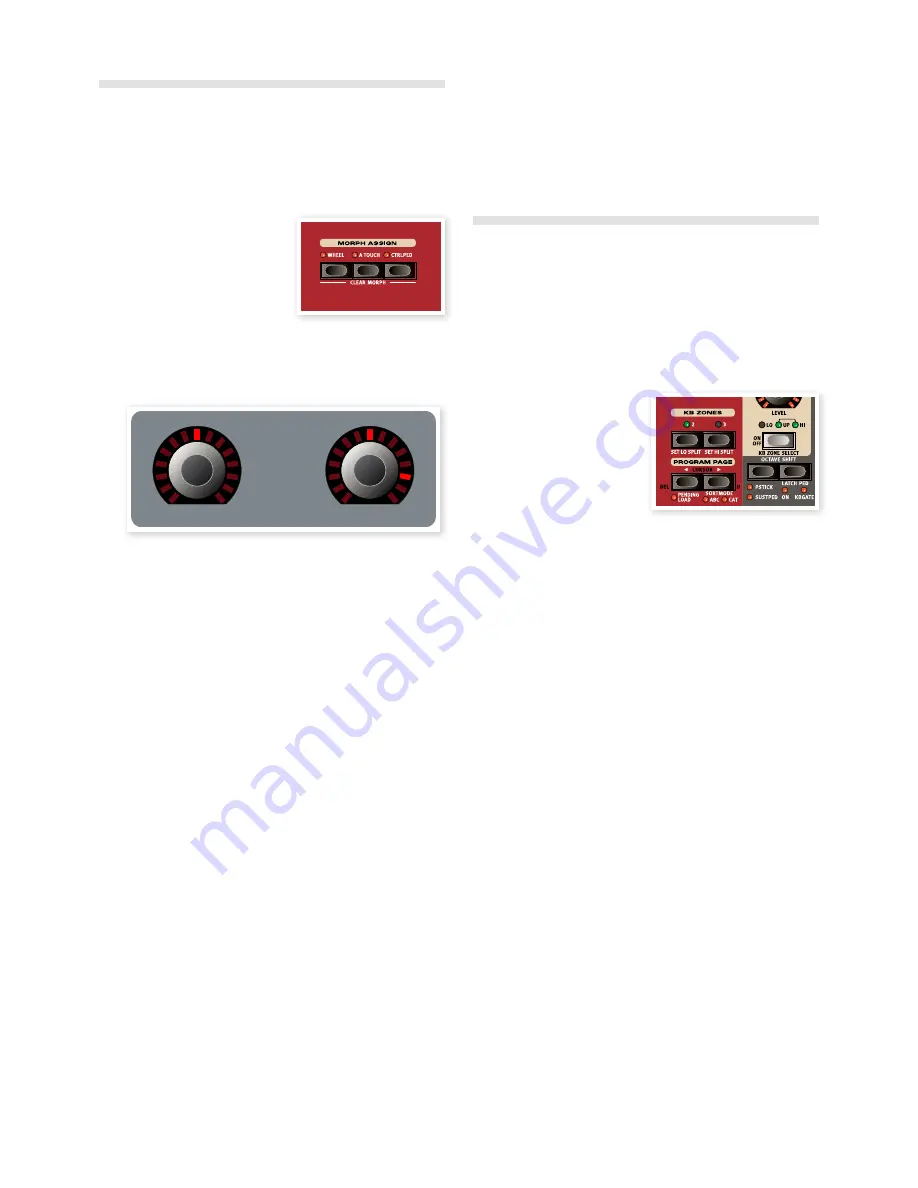
Morph Assign
The Morph is a very powerful tool, which allows you to control several
parameters at once with one “source”. You can use a foot pedal to
control the level balance between a piano and a synth sound, use the
wheel to do a major change in the drawbar settings of a B3 sound, and
increase the amount of a selected effect by aftertouch - all at the same
time.
The three Morph Assign buttons
represent the three Morph Sources
and are located above the Program
Bank buttons.
You activate a Morph by holding one
of the Morph Assign buttons and at the same time operate a parameter
knob in the desired direction. It is important to note that you should en-
sure that the parameter(s) you wish to include in your morph are stored
at the desired “starting” value(s) before starting this procedure.
The setting of the parameter in the program is the “first” setting (shown
on the left dial here), and then you turn the knob to the second setting,
which will be the maximum setting that can be set with the Morph
source.
If you double-tap on a Morph Assign button, the Morph as-
sign mode will latch and you can take your time to adjust one or
several parameters to the desired effect. Press the button again to
exit the latched mode.
One Morph Source can control several parameters at the same time.
Morphs can also influence parameters in both positive and negative
directions.
Morphs operate across the two Slots.
Morph Destinations
You can use the Morph to control all the settings of the rotary encod-
ers (the knobs that show parameter values with LEDs), the Rotary
speed and the organ drawbars. Apart from the number of assignable
parameters, there is no limit to how many parameters you can control
simultaneously using Morph.
The following parameters can be controlled by the Morph sources:
• The Level setting for all Instruments.
• The Shape setting in the Synth oscillator section.
• The filter Frequency setting in the Synth filter section.
• The Drawbars in the Organ section.
• The Effect Rate/Tempo setting for the individual effects.
• The Effect Amount setting for the individual effects.
• The Parameter setting in the Extern section (read more on page 40).
• The Rotary Speed (only with the Wheel option. This enables you to
set Rotor Speed continuously, instead of just alternating between two
fixed speeds.
Clearing a Morph
Hold Shift and press a Morph Assign button to clear all Morphs for
this source on the Slot in focus. To clear a particular assignment, hold
the Morph Assign button and operate the control to remove the “gap”
between the programmed setting and the Morph setting.
KB Zones
The Nord Stage 2 EX keyboard can be split in up to three keyboard
zones; Lower (LO), Upper (UP) and High (HI). Any of the Instrument
sections can then be assigned to any (or all) of these zones.
The KB Zones buttons split the Stage 2 EX’s keyboard into two or
three zones. After you have activated a split, use the On/Off - KB Zone
Select buttons beneath each instrument’s (or the Extern’s) Value Dial to
assign an instrument to one or more zones.
When a split is active, hold Shift and repeatedly press an instrument’s,
or the Extrern’s KB Zone Select button to assign the instrument to one
or several zones. The three Zone LEDs beneath the instrument’s Level
Rotary will indicate the assignment.
Hold Shift and press KB2 or KB3 to move the boundaries of the lower,
upper and high zones. The split points are indicated by green LEDs
above the keyboard.
M
Both Slots use the same KB Zone configuration, instrument as-
signments are individual.
Read more on creating splits on page 20.
Chapter 4 program SeCtion
| 19
Summary of Contents for NordStage2 EX 88
Page 60: ......






























